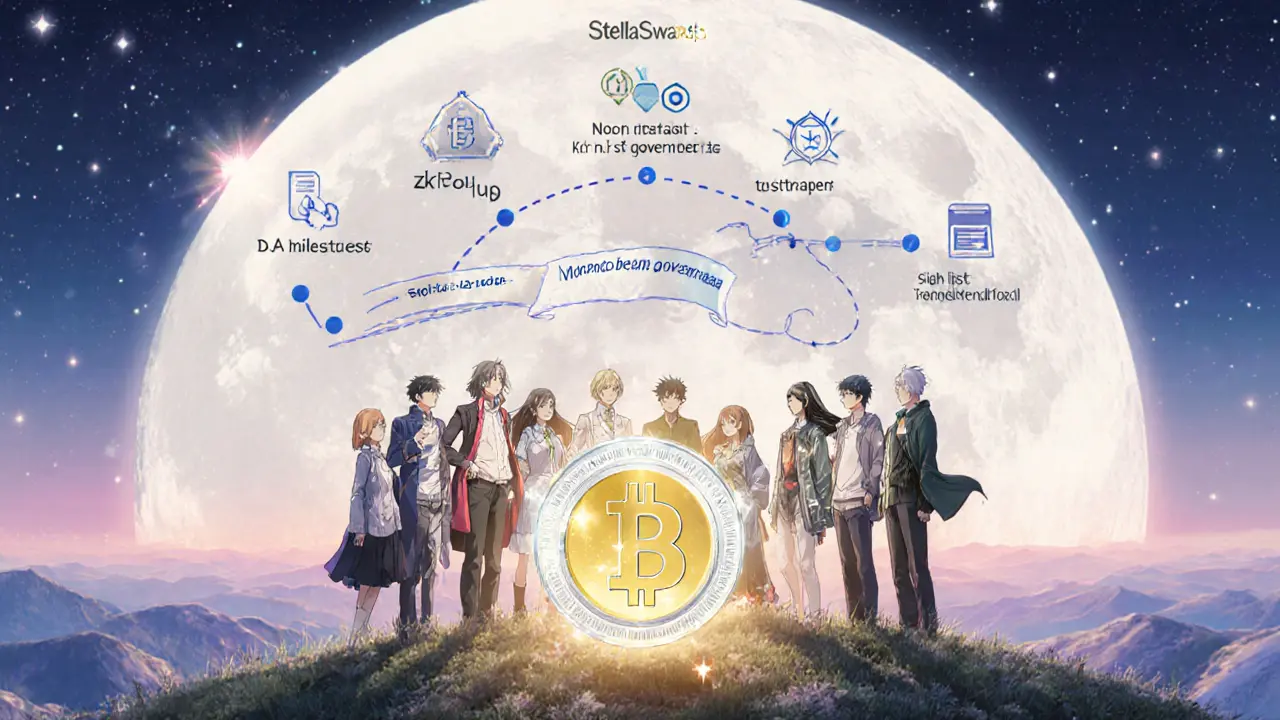StellaSwap Fee Calculator
Fee Calculation Results
Trade Amount: $0.00
Fee Rate: 0.30%
Estimated Fee: $0.00
Net Received: $0.00
Note: This calculator estimates fees based on the standard 0.30% rate. Actual fees may vary based on market conditions and slippage.
StellaSwap review offers a clear picture of why this Moonbeam‑based DEX is gaining traction in the Polkadot DeFi scene. Below you’ll find the most important points, a step‑by‑step guide to using the platform, and a side‑by‑side look at its rivals.
Key Takeaways
- StellaSwap runs on Moonbeam, an EVM‑compatible parachain that lets Ethereum wallets connect instantly.
- Low‑slippage AMM design makes it attractive for medium‑sized trades.
- The native STELLA token is both a governance and revenue‑sharing token.
- Cross‑chain swaps are handled through Axelar, allowing 1‑click moves between Moonbeam, Ethereum and other networks.
- Compared with Polkadex and Zenlink, StellaSwap stands out for its TradingView charts and EVM friendliness.
What Is StellaSwap?
StellaSwap is an Automated Market Maker (AMM) decentralized exchange built on Moonbeam, an EVM‑compatible parachain of Polkadot. Launched in 2022, it aims to be the primary gateway to Moonbeam’s DeFi ecosystem while solving the liquidity fragmentation problem that plagues many DEXs.
Unlike centralized exchanges, StellaSwap never holds users’ funds. Swaps happen directly from the user’s wallet, meaning you retain full custody throughout the transaction.
How It Works - Technical Overview
The platform leverages the same AMM formulas used by Uniswap, but it tailors pool parameters to keep price impact low. Because Moonbeam mirrors the Ethereum Virtual Machine, you can connect familiar wallets like MetaMask without learning Polkadot‑specific tooling.
When you initiate a swap, the smart contract pulls the input token from your wallet, runs the constant‑product formula, and pushes the output token back. All of this happens in a single transaction, so there are no hidden “deposit” steps.
Cross‑chain functionality is powered by Axelar. Axelar’s protocol routes messages between Moonbeam, Ethereum, and other supported chains, so the user experience feels like a single‑click swap even though multiple networks are involved behind the scenes.

Core Features
- Low‑slippage trading: The AMM parameters are calibrated for the 13 listed coins and 14 pairs, keeping price impact under 0.5% for most medium‑size trades.
- Integrated TradingView charts: StellaSwap embeds TradingView widgets, giving traders access to candlesticks, indicators, and drawing tools usually reserved for centralized platforms.
- One‑click cross‑chain swaps: Axelar’s bridge abstracts the multi‑step process, letting users move assets between Moonbeam, Ethereum, and Binance Smart Chain with a single click.
- Single‑asset liquidity provision: The “auto‑split” feature takes a single token (e.g., USDC) and automatically creates the correct ratio for the target pool, simplifying liquidity provision for newbies.
- Staking & governance: Holding STELLA grants voting rights and a share of 100% of protocol revenue, distributed weekly to stakers.
Tokenomics and Staking
The native token, STELLA, serves three purposes:
- Governance: Token holders vote on fee structures, new pool listings, and protocol upgrades.
- Revenue sharing: All swap fees (0.30% per trade) flow into a revenue pool that is distributed proportionally to stakers.
- Incentive alignment: Liquidity providers earn additional STELLA rewards on top of fee earnings, encouraging deeper pools.
Current supply sits around 200million tokens, with a circulating amount of roughly 120million. Price forecasts from 3Commas (Aug2023) range between $0.033 and $0.043 for 2025, while Coinbase’s conservative model predicts roughly $0.04 by October2025.
Comparing StellaSwap to Other Polkadot DEXs
| Feature | StellaSwap | Polkadex | Zenlink |
|---|---|---|---|
| EVM Compatibility | Yes (Moonbeam) | No (native Polkadot) | No (native Polkadot) |
| # of Tokens | 13 | ≈25 | ≈20 |
| # of Pairs | 14 | ≈30 | ≈28 |
| Cross‑chain Swaps | 1‑click via Axelar | Manual bridge | Manual bridge |
| TradingView Charts | Integrated | Basic | Basic |
| Average Daily Volume (USD) | $2.1M | $0.8M | $0.9M |
| Liquidity Incentives | STELLA rewards + fee share | Native reward token | Native reward token |
StellaSwap’s biggest edge is its Ethereum‑friendly environment. Users who already have MetaMask set up can start swapping without installing Polkadot‑specific wallets, which lowers the entry barrier considerably.

User Experience & Security
Connecting a wallet is a three‑step process: click “Connect”, choose MetaMask (or any EVMwallet), and authorize the connection. The UI mirrors popular Ethereum DEXs, showing token balances, price impact, and slippage tolerance sliders.
Security-wise, StellaSwap inherits Moonbeam’s shared security model-Moonbeam validators secure the parachain, and the underlying Polkadot Relay Chain provides additional finality guarantees. However, because the platform is still a smart‑contract based AMM, users remain exposed to typical risks like impermanent loss and potential contract bugs. The codebase is open‑source on GitHub, and regular audits from Quantstamp (June2023) have found no critical vulnerabilities.
Regulatory note: Crypto Tax Calculator (Oct2023) warns that each swap generates a taxable event in most jurisdictions, so keep detailed transaction logs.
Risks & Considerations
- Limited token selection: Only 13 coins are listed, which may frustrate traders looking for niche assets.
- Dependence on Moonbeam: If Moonbeam’s adoption stalls, StellaSwap could suffer from reduced liquidity and network congestion.
- Impermanent loss: Providing liquidity still carries the classic AMM risk, especially for volatile pairs.
- Cross‑chain bridge risk: While Axelar is reputable, any bridge introduces an extra attack surface.
Future Outlook
StellaSwap’s roadmap (v4 in early 2026) mentions expanding the token list to 30+ assets, deeper integration with Moonbeam’s upcoming zk‑Rollup layer, and launching a DAO‑driven treasury for community proposals.
If Polkadot’s parachain ecosystem continues to grow, StellaSwap could become the de‑facto bridge for Ethereum users entering Polkadot. Its focus on low‑slippage AMM design and one‑click cross‑chain swaps positions it well against competitors that still rely on manual bridging.
Frequently Asked Questions
How do I connect MetaMask to StellaSwap?
Open the platform, click the “Connect Wallet” button, select MetaMask, approve the connection in the MetaMask pop‑up, and you’re ready to trade.
What is the fee structure on StellaSwap?
Each swap charges a flat 0.30% fee, which goes into the liquidity pool and is later distributed to STELLA stakers.
Can I provide liquidity with a single token?
Yes. The “auto‑split” tool takes your chosen token, converts half to the paired asset, and adds both to the pool automatically.
Is StellaSwap safe to use?
Security depends on Moonbeam’s validator set and the smart‑contract audits. So far, audits have found no critical flaws, but users should still be aware of AMM risks.
How does the STELLA token generate revenue?
All swap fees are collected in the protocol’s revenue pool. 100% of this pool is distributed proportionally to STELLA stakers each week.
Whether you’re a DeFi newbie or an experienced trader looking for low‑slippage Polkadot swaps, StellaSwap offers a compelling mix of Ethereum familiarity, cross‑chain convenience, and revenue‑sharing incentives. Keep an eye on its token list expansion and upcoming Moonbeam upgrades-they’ll shape how useful the platform remains in the fast‑moving DeFi landscape.


Post Comments (2)
Looks decent, but idk if the fees are worth it.
StellaSwap’s 0.30% fee isn’t crazy high compared to other Moonbeam DEXs, especially when you get that portion back as STELLA rewards. The staking mechanism actually lets you earn a slice of the collected fees, so heavy traders can offset costs over time. Just make sure you’re comfortable with the lock‑up period on the staked tokens – you don’t want your liquidity frozen when the market swings. Also, keep an eye on gas fees; on low‑traffic days they can eat a chunk of your profit.